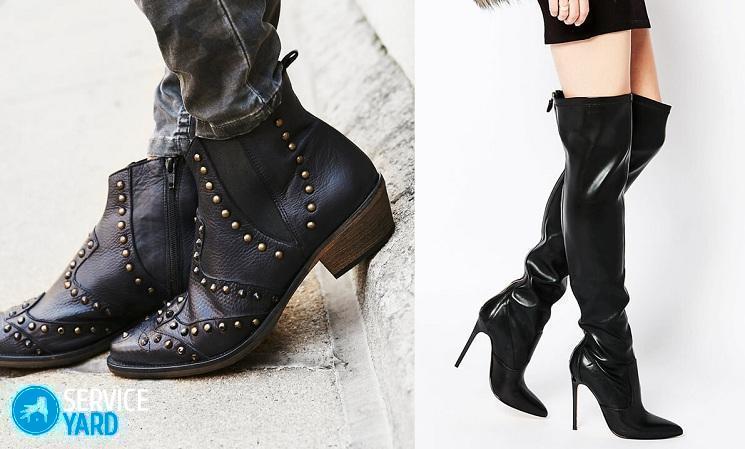Slippery boots - what to do at home?

With the onset of winter, many are faced with the problem of slippery shoes. Walking on the ice surface so as not to fall on the ice becomes very difficult, and ordinary walks in the fresh air become a difficult task. Very often, the falls end with a trip to the traumatologist. In this regard, the question arises: if slippery boots, shoes what to do? What shoes do you need to be slippery? At home, there are several ways to solve the problem. They will be discussed in this article.
to contents ↑Effective anti-slip shoes
There are proven methods for dealing with slippery soles of winter boots - from simple folk methods to specially designed products.
Folk methods:
- Potatoes. Rub the bottom of the shoe with a small piece of chopped vegetable. Starch can make the product less slippery.
Important! It should be understood that the effect of this method will last a maximum of 30 minutes, after which the starch is simply erased.
- Medical plaster. It must be glued to the boot crosswise, after which it will become more stable on the ice surface.
Important! This method is enough for 1-2 days to wear winter boots.
- Sandpaper. It is necessary to choose a material with a fabric base that can easily stick to the sole.
Important! Sandpaper cover lasts for about a week toe boots in ice.
- Glue and sand. The effect of sandpaper can also be achieved by applying glue to the bottom of the product, then sprinkling it with sand. Shoes should dry in this form during the day.
- Felt. Here's what you can do to keep your boots from slipping: cut off a piece of felt from an old felt boot and stick it to the sole. The method is more effective and reliable than the previous ones.
Radical methods:
- Wood screws. This method is suitable for boots with thick soles. Small screws are screwed into shoes and cut so that small ends remain on the outside. However, the method has drawbacks: when walking, such boots emit a corresponding sound. In addition, in a room, a similar method can damage the floor covering.
- Staples. The anti-slip effect can also be achieved with staples applied by a construction stapler.
Important! Answering the question of what can be done if boots slip, it is necessary to correctly evaluate the rationality of the methods in each case individually. It should be understood that the described radical methods can damage the sole of not very high quality.
Professional methods:
- Ledostupa. In hardware stores you can buy special pads with metal spikes that are attached to the shoes. Devices are quite practical, but not everyone may like it.
- Rubber pads. Shoe stores sell special rubberized pads. The device is the most optimal and easiest to use method in the fight against slippery shoes. They need to be attached to the sole before going out and removed upon returning home.
- Polyurethane protection. In shoe repair workshops, you can put a special embossed surface on the bottom of the products. In deciding what to do if the boots slip, this method is quite effective and popular.
What methods are suitable for children's shoes?
For children it is better to choose the safest and most practical methods.Since the kids lead an active lifestyle, then shoes should maintain their functionality during children's games:
- The best ways to deal with slippery shoes of a child can be considered professional relief protection and special pads.
- From folk methods, one can distinguish a method using felt or sandpaper.
The remaining methods described are not suitable for mobile children and are not reliable.
to contents ↑Tips for choosing winter boots
To avoid future questions, what to do if the boots are slippery soles, follow these simple tips:
- Never take winter boots with a smooth sole. Choose deep-soled shoes with soles. It is desirable that the direction of the tread was in different directions. Such products will provide good adhesion to the surface.
- When trying on boots in a store, be sure to walk and make sure that the sole does not slip. This is easy to do, given that the floor in shoe stores is usually made of floor tiles, which have a slippery surface.
- Great attention should be paid to the softness of the sole. It is believed that the softer the material of the bottom, the more stable the boots.
- The rubberized sole also has anti-slip properties, and the special EVA material is not afraid of ice or frost.
Stock footage
In deciding what can be done so that the boots do not slip in the winter at home, there are many options. Which one is right for your shoes should be considered individually, depending on the quality of the material of the boots and the materials available.
- How to choose a vacuum cleaner taking into account the characteristics of the house and coatings?
- What to look for when choosing a water delivery
- How to quickly create comfort at home - tips for housewives
- How to choose the perfect TV - useful tips
- What to look for when choosing blinds
- What should be running shoes?
- What useful things can you buy in a hardware store
- Iphone 11 pro max review
- Than iPhone is better than Android smartphones




